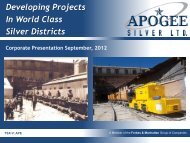Pulacayo Project Feasibility Study - Apogee Silver
Pulacayo Project Feasibility Study - Apogee Silver
Pulacayo Project Feasibility Study - Apogee Silver
You also want an ePaper? Increase the reach of your titles
YUMPU automatically turns print PDFs into web optimized ePapers that Google loves.
<strong>Pulacayo</strong> 1 000 t/d Phase I <strong>Feasibility</strong> <strong>Study</strong> - NI 43-101 Technical Report<br />
090644-3-0000-20-IFI-100<br />
accommodated through their blind inclusion in the sample stream and analysis of duplicate<br />
prepared pulp splits are also requested for each batch.<br />
<strong>Apogee</strong>`s protocol also includes a check sampling program based on analysis of sample<br />
splits at a second accredited laboratory. Check samples submitted to the check laboratory<br />
are processed using the same preparation and analytical techniques as used by ALS in Lima.<br />
The ALS laboratory in La Serena, Chile provided initial second laboratory analytical services<br />
for the <strong>Apogee</strong> programs, results of which are discussed in report Section 13. Since January<br />
2010, starting with drill hole PUD 140 samples, all check analyses are done at SGS in Lima,<br />
Peru.<br />
In addition to chemical analysis, bulk density measurements (specific gravity) were<br />
systematically collected by <strong>Apogee</strong> staff using standard water emersion methods and<br />
unsealed core samples. Micon (Pressacco and Shoemaker, 2009) reviewed ASC and early<br />
<strong>Apogee</strong> density determination methods and recommended that these be modified to include<br />
more representative sampling methods in non-mineralized areas, and be carried out<br />
continuously through mineralized zones. Procedures were subsequently modified and<br />
measurements thereafter were collected for continuous 10 m sampled intervals where no<br />
observed sulphide mineralization was present and for all sampled intervals within recognized<br />
mineralized zones. Micon also noted that samples were not being wax sealed and advised<br />
that sealing would be advisable for some samples due to higher porosity and low<br />
permeability seen in some samples. Characteristics of lithology and alteration were also<br />
recorded as part of the density program and all information was assembled in digital<br />
spreadsheets. Results of the density measurement programs appear in report section 13.<br />
The authors are satisfied that <strong>Apogee</strong>’s sample preparation, analysis and security<br />
methodologies are sufficient for a project of this size and that suitable precautions are being<br />
taken to identify irregularities in sample analytical results.<br />
11.6 Quality Control and Assurance for ASC 2002-2003 Programs<br />
QAQC procedures pertinent to the ASC programs were not documented in support<br />
information reviewed by Mercator for this report. However, the first drilling program carried<br />
out by <strong>Apogee</strong> in 2006 consisted of 19 holes totaling approximately 4,150 m drilled to confirm<br />
earlier ASC analytical data. Full QAQC protocols instituted by <strong>Apogee</strong> were applied to this<br />
program and results of an <strong>Apogee</strong> re-drill program correlate well with those of ASC. Such<br />
correlation suggests that acceptable standards were being met by ASC.<br />
TWP Sudamérica S.A. Av. Encalada 1257 Of. 801, Santiago de Surco Lima 33, Perú (51-1) 4377473<br />
Page 63



